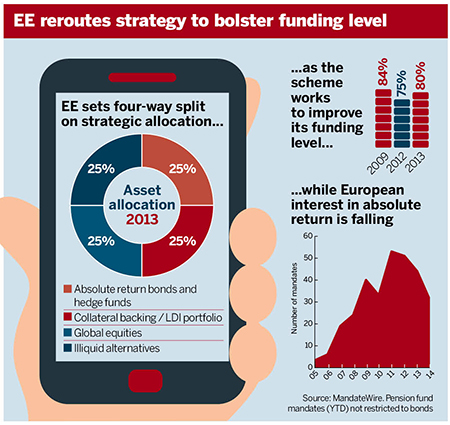The largest UK mobile group’s defined benefit pension scheme is removing a set allocation to index-linked gilts in favour of absolute return bonds and hedge funds, the latest institutional investor to reset its portfolio in a hunt for value.
Absolute return bonds have become popular with DB schemes looking for greater yield than currently offered by UK gilts, while also managing volatility. The DB section comprises £450m of EE’s £908m hybrid fund.

The scheme has been in the process this year of dismantling its discrete £78m holding in index-linked gilts, while increasing its allocation to absolute return bonds and hedge funds to 25 per cent at the end of 2013, from 5 per cent at the same time the previous year. The changes were revealed in its annual report and accounts, published online this month.
The scheme has also allocated 25 per cent of its assets to a liability-driven investment and collateral backing portfolio (see graphic). Formerly the T-Mobile (UK) Pension Scheme, it was renamed in July 2011 after a merger between T-Mobile and Orange. The Orange Pension Scheme was transferred into a ringfenced section of the new scheme.
The DB investment strategy was reviewed in December 2013 and has been implemented throughout this year, splitting assets equally between four portfolios: absolute return bonds and hedge funds; illiquid alternatives; the LDI strategy; and global equities.
Euro v UK appetite
Mark Nicoll, partner at consultancy LCP, said absolute return bonds can be a good alternative to conventional corporate bonds when used in conjunction with an LDI strategy. “They don’t give you any duration hedging so they match what long-term interest rates are doing, if they go up or down,” he said.
However, according to data from Financial Times service MandateWire, fewer schemes across Europe have been seeking to increase their allocation to absolute return strategies.
Olivier Lebleu, head of international distribution at Old Mutual Asset Management, said UK schemes have been more willing to invest in absolute return bonds because they are further along the derisking path than their counterparts in continental Europe.
“So you have to find cash flow-matching assets and then you go to the bond markets, [but] with the Bank of England buying so many bonds, you don’t have that much merchandise to buy.”
He added that some European schemes who had greater holdings in absolute return strategies in the financial crisis and the period immediately following suffered bigger losses, causing a backlash.
But Simeon Willis, partner at consultancy KPMG, said absolute return bonds have remained popular with UK schemes. “They allow a scheme to manage their LDI hedge separately to their bond returns so it becomes much clearer whether the bond manager is underperforming or outperforming,” he added.
EE closed its DB section to future accrual from July 1 this year and transferred members into the scheme’s defined contribution section, granting these members enhanced terms.
The DB section’s investments returned 8.1 per cent in 2013, failing to hit its 9.7 per cent benchmark return. The £450m DB section’s funding level rose to 80 per cent at the end of 2013 from 75 per cent at the same time the previous year, according to the section’s most recent newsletter.
However the DB section’s funding level was 84 per cent at the time of the previous valuation in 2009.














